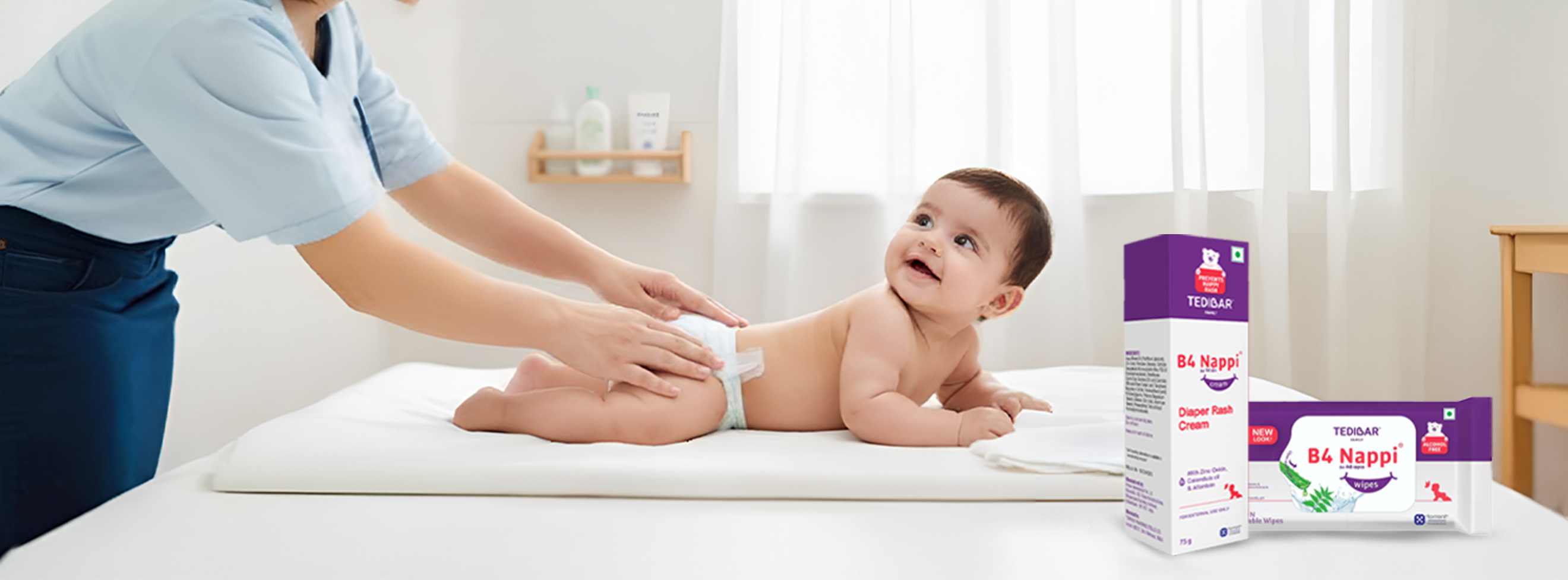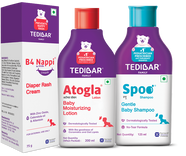

Say Goodbye to Nappy Rash – Easy Tips Every Parent Should Know
2025-10-15 - B4 Nappi Cream & Wipes
Nappy rash, also known as diaper rash, is one of the most common skin concerns faced by babies in their early months. It causes redness, inflammation, and discomfort in the diaper area and can be distressing for both babies and parents. The good news is that with the right routine and baby skin care products, nappy rash can be easily prevented and treated.
In this blog, we share simple tips to manage and prevent diaper rash using the effective baby skin products, including trusted solutions from the Tedibar Family Baby Care Range.
What Causes Nappy Rash?
Understanding the root causes of nappy rash can help in preventing flare-ups. Common causes include:
- Diaper rash is usually caused by wetness and friction.
- Urine and stool (pee and poop) can cause even more irritation, and this leads to breakdown of the skin.
- Products used to clean the skin can sometimes add to the irritation.
- Once the skin under the diaper becomes irritated, germs like bacteria and yeast can infect the skin and worsen the rash.
Recognizing the Signs¹
Nappy rash typically appears as:
- Redness and inflammation in the diaper area
- Small bumps, patches, or sores in diaper area and/or genitals
- Fussiness or crying during diaper changes
Early action with suitable baby skincare products can reduce discomfort and speed up healing.
Easy Tips to Prevent and Treat Nappy Rash – Using the ABCDE Concept²
When it comes to keeping your baby’s bottom healthy, the ABCDE method offers a simple and effective framework:
A – Air
Give your baby frequent diaper-free time to let the skin breathe. This air exposure helps reduce friction and prevents moisture build-up that contributes to nappy rash.
B – Barrier
Apply a thick layer of protective diaper cream for rash at every diaper change. This forms a barrier to protect delicate skin from wetness and irritants. Look for ingredients like zinc oxide, panthenol, or allantoin.
C – Cleansing
Clean the diaper area gently using lukewarm water and a soft cloth, or opt for hypoallergenic wipes free from alcohol and fragrances. Avoid harsh scrubbing.
D – Diapering
Use super-absorbent diapers and change them promptly after soiling—or at least every 2–3 hours—to reduce contact with moisture and irritants.
E – Education
Parents and caregivers should be educated about the importance of handwashing, proper diaper routines, and recognizing early signs of rash. This proactive understanding supports timely action and reduces recurrence.
Choosing the Right Nappy Rash Cream
You can check Tedibar B4 Nappi Cream for Diaper Rash.
The Tedibar Family Baby Care Range offers a gentle yet effective nappy rash cream that3:
- Forms a protective layer between skin and nappy.
- Relieves discomfort caused by diaper rashes and prevents recurrence with regular use.
- Is free from harsh chemicals.
- Is dermatologically tested for daily use.
Be Mindful of Baby Skin Products
Avoid using talcum powders or heavily fragranced lotions in the diaper area. Stick to baby skin care products specifically designed for sensitive skin.
Nappy rash is a common part of babyhood, but it doesn’t have to be a painful one. With consistent hygiene, breathable diapers, and the right diaper cream for rash, your baby can stay comfortable and happy.
Explore the Tedibar Family Baby Care Range to find safe, gentle, and suitable solutions for everyday baby skincare needs. From nappy rash creams to gentle baby skincare products, Tedibar has a trusted range for your parenting journey.
Say goodbye to nappy rash—and hello to happy, healthy baby skin!
Use nappy rash cream for mild rashes and only see a doctor if the rashes persist.
References:
1.https://www.healthdirect.gov.au/nappy-rash
2.https://www.rainbowhospitals.in/blog/diaper-rash-understanding-prevention-and-parent-education
3.https://www.amazon.in/B4-Nappi-Cream-75-G/dp/B01MZWH6ZV?source=ps-sl-shoppingads-lpcontext&ref_=fplfs&smid=A15APWRK6P7LBV&th=1






